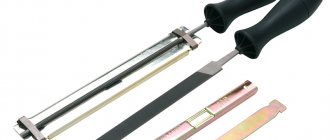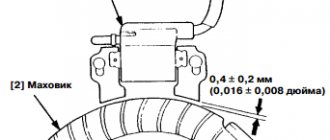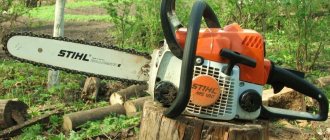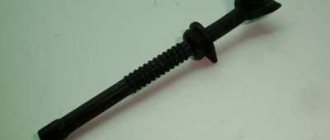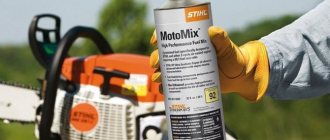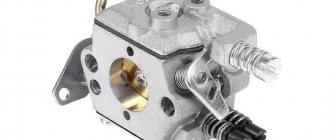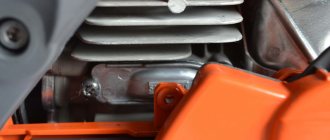Powered by gasoline | 03/22/2017
When actively working on trimming dead wood or expanding the area of a personal plot, the home workshop must have a chainsaw. Chainsaw teeth, even from a trusted brand (for example, Stihl), periodically wear out and therefore require high-quality sharpening. In the absence of special devices, a properly selected file for sharpening a chainsaw chain will help solve this problem.
Features of the chainsaw
Cutting wood is similar to working with a plane.
In all this, the size of the cut depends on the thickness of the limiter. When the saw chain works in a saturated mode, the teeth become dull faster. Chain sharpening. File diameter 5 chain file. This is clearly manifested when the ground surface melts in the path of the chain. To blunt the teeth one hundred percent, it is enough to “catch” on the ground for a couple of seconds. If you are able to sharpen it frequently, the chain will last even longer, since very little metal will be removed. In addition to the question of what angle of sharpening the chainsaw chain should be, you also need to know this!
There is no need to work with blunt equipment for a number of reasons. At first, this affects the quality of the cut, but not for the best. Lethargy also quickly sets in, which is felt not only in the hands, but also in the body.
Another reason. unjustified excessive consumption of fuel. All parts will work in increased mode, which inevitably leads to rapid wear. Performance drops seriously, which also happens when using a defective chain.
To be able to sharpen a chainsaw chain perfectly, you should know the structure of its teeth. You can’t do without knowing the sharpening angle. Each tooth has a complex structure. Its geometry is represented by the following components:
- basis;
- spatula;
- depth limiter.
With all this, the blade consists of two blades: the end blade and the top blade. At the same time, there must be the correct sharpening angle of the chainsaw chain between them in order to provide it with the required performance.
How can you figure it out now? It is not the chain that cuts the tree, since it serves as the basis for securing the cutting links and moves them at the highest speed. The links themselves have sharp blades, with the help of which the wood is cut.
Important features when sharpening
If you work with a file and are ready to sharpen it yourself, pay attention to the following nuances and recommendations:
A standard file will sharpen a chain a maximum of 2 times;
Cleaning up shavings is most convenient with a crochet hook;
Mechanical sharpening with a file is faster and cheaper than using a grinder or a machine;
To determine the height you will need a template;
You can buy a file for sharpening a chainsaw at chainsaw stores;
It is advisable to sharpen teeth from problem areas first.
At first glance, the procedure seems complicated, but after the first successful attempt, you will understand how to properly sharpen a chainsaw chain right at your workplace.
Two files of different diameters for proper sharpening of a chainsaw chain
The chain is considered an important part of any chainsaw, because with its help all work with trees is performed. Therefore, when using a chainsaw frequently, the chain needs periodic maintenance, and one of these points is sharpening the chain with a round file.
You need to understand that you won’t be able to sharpen a chain with an ordinary round file, much less a flat or triangular file, since a file for a chain must have its own parameters. Although it’s worth making a note here - you can sharpen the depth limiter with a simple flat file.
- The first step is to select the required diameter of the round file. The table above shows the diameters depending on the chain pitch.
- Before sharpening, be sure to thoroughly clean the chain of sawdust, resin and other “extra” items. This can be done using a special product, a soft metal brush, or improvised means.
- Sharpening chain cutting teeth. If you use a round file without additional devices, then you need to firmly fix the file and maintain the correct angle (for cross-cutting chains it is 30 degrees, and for longitudinal sawing it is 10) and move the file back and forth. In this case, it is advisable to press on the file only when moving forward. You should start with the shortest tooth.
- If you have a control device, then after you are sure that the tooth has been sharpened, you need to check it.
- If you have nothing to check the correct sharpening, then advice from Stihl will help: light should not be reflected from the cutting edge.
The light is reflectedNo light reflected
- After sharpening the cutting edges of the teeth, you also need to sharpen the depth stops. It is especially convenient to do this using a control gauge from Stihl, but it can also be done manually or using other devices.
Tell us how to sharpen a chainsaw chain with a file? What are the subtleties?
Chain sharpeners
One of the common chain sharpening kits consists of a round file mounted in a special holder, a flat file for grinding down the depth stop, a template for the final operation, and a hook for cleaning the sawdust from the saw.
The round file holder has lines that allow it to be positioned correctly relative to the chain. The holder is installed on the tooth being sharpened in accordance with the orientation lines. In this case, the plate itself rests on the upper edge of the tooth and the depth stop, and the file is located under the cutting edge.
Using a holder ensures that the file rests on the tooth at the correct height. There are different holders available for different saw chain pitches. The correct choice of holder in combination with the correct file diameter ensures that the file extends 1/5 of its diameter above the back of the tooth. Use only special files for sharpening saw chains.
Before sharpening the chainsaw chain, it is advisable to secure the bar. When sharpening, it is necessary, while maintaining the position of the holder and pressing the file against the edge being sharpened, to make several (2-3) turning movements away from you. There is no need to try to press the file too hard; movements should be smooth and measured.
When sharpening all teeth, make the same number of file strokes using the same pressure. This will ensure that the teeth have the same length. All cutting teeth must be the same length.
Different tooth lengths cause uneven movement of the chain and the formation of cracks in it. If the tooth lengths are not the same, all cutting teeth should be filed to the length of the shortest tooth.
After several sharpenings of the cutting teeth, the depth stop is ground off. To do this, a template is placed on it so that the stop fits into the slot, and the tip protruding from the slot is ground off with a flat file.
Since the internal contour of the tooth surface is close in shape to a circle, and the metal of the chain is quite soft, the chain is sharpened with a round file of small diameter. Sharpening a chainsaw requires precise positioning of the file relative to the tooth being sharpened. Its position should be such that the upper edge of the file protrudes relative to the upper edge of the tooth by approximately 1/5 (20%) of the file diameter. Before sharpening a chainsaw chain, it is advisable to know its parameters, since the file diameter should be selected depending on the chain pitch.
Usually it fluctuates in the range of 4-5.5 mm. In addition, it is necessary that the file is located at an angle of 90° to the chain in the vertical plane and 30° or 10° (see Parameters of chain teeth) in the horizontal plane. It is quite difficult to fulfill all these conditions using only a file, so when sharpening a saw, various devices are used to ensure the necessary sharpening parameters.
The principle of using another kit for sharpening chainsaw chains is no different from the first, although its design is different.
A round file is also used to sharpen the cutting tooth, and a flat file is used to sharpen the depth stop. A special template provides sharpening parameters for both cutting teeth and stops. In the first case, it is placed on the chain so that it fits into its slots. The file, placed on the template and brought under the cutting edge, rests on the guide rollers. The direction of movement of the file should be parallel to the side edges of the template.
Currently reading: Chainsaw FORWARD FGS-4504: review and reviews
When grinding the stopper, the template is applied so that the stopper fits into the slot, next to which it says SOFT (for soft wood) or HARD (for hard wood). As in the case of the first device, grinding is done with smooth, even movements of the flat file away from you.
How to choose a file for sharpening a chain for a chainsaw JOIN VSP GROUP PARTNER PROGRAM: .
The sharpening angle of chainsaw chains is not a constant value and does not depend on the manufacturer or model of equipment. It is selected taking into account what kind of tree you will be dealing with. You can choose some average value, but the cutting efficiency may be ineffective. For this reason, it is necessary to choose the correct value, taking into account the specific type of wood.
If we are talking about solid wood, including those trees that have been “frozen” for a long time, it has a high resistivity. In this regard, the sharpening angle should be reduced. This will practically avoid the occurrence of vibrations, and the movement of the chain will be softer. The minimum value is 25°.
Chain file
You need to understand that you won’t be able to sharpen a chain with an ordinary round file, much less a flat or triangular file, since a file for a chain must have its own parameters. Although it’s worth making a note here - you can sharpen the depth limiter with a simple flat file.
File parameters for chain sharpening
The most important parameter of a file for sharpening a chain is its diameter. It is important because, depending on the pitch of the chain, a file of a certain diameter is used. Below is a table showing which file is suitable for a chain with a particular pitch.
| Chain pitch (mm) | Link thickness (mm) | File diameter (mm) | Sharpening angle (degrees) | Cutting tooth inclination degree |
| 1/4″(6.35mm) | 1,1-1,3 | 4 | 30 | 0.65 mm |
| 3/8″ Picco/Micro (9.3 mm) | 1,1 | 4 | 30 | 0.65 mm |
| 3/8″ Picco/Micro (9.3 mm) | 1,3 | 4 | 30 | 0.65 mm |
| 3/8″ Picco/Micro (9.3 mm) | 1.3 (for rip sawing) | 4 | 10 | 0.65 mm |
| 0.325″ (8.25 mm) | 1,3 | 4,8 | 30 | 0.65 mm |
| 0.325″ (8.25 mm) | 1,5 | 4,8 | 30 | 0.65 mm |
| 0.325″ (8.25 mm) | 1,6 | 4,8 | 30 | 0.65 mm |
| 0.325″ (8.25 mm) | 1.3-1.6 (for longitudinal sawing) | 4,8 | 10 | 0.75 mm |
| 3/8″ (9.3 mm) | 1,3 | 5,5 | 30 | 0.65 mm |
| 3/8″ (9.3 mm) | 1,5 | 5,5 | 30 | 0.65 mm |
| 3/8″ (9.3 mm) | 1,6 | 5,5 | 30 | 0.65 mm |
| 3/8″ (9.3 mm) | 1.3-1.6 (for longitudinal sawing) | 5,5 | 10 | 0.75 mm |
| 0.404″ (10.26 mm) | 1,6 | 5,5 | 30 | 0.75 mm |
| 0.404″ (10.26 mm) | 1.6 1.3-1.6 (for rip sawing) | 5,5 | 10 | 0.75 mm |
In addition, it is necessary to take into account that most files are sold without a handle. It should be purchased separately. This, of course, does not apply to file sets, in which most files are equipped with handles.
Chain sharpening accessories
Without a doubt, an experienced chainsaw user will be able to sharpen a chain without various auxiliary devices and accessories, which is called “by eye.” But for this you need to have experience, which you must first gain. And this is much more convenient to do with the help of various devices that will allow you to sharpen the chain correctly. Let's look at the most popular of them.
Reference caliber
This device allows you to:
- Check the distance to the depth stop
- Check the sharpening angle of the cutting teeth of the chain
- Clean the groove and measure its depth
- Determine the front angle of the tooth
That is, with the help of a control gauge, after you have carried out preliminary sharpening, you can determine whether it was done correctly. It would be a good idea to take measurements before you start sharpening the chain. Manufactured by Stihl.
Clamping holder
This simple device allows you to sharpen the chain at the required height and at the desired angle. It fits tightly to the tooth and limits the depth of the file. And thanks to the risks applied, you will be able to control the required angle. It is necessary to select a holder based on the pitch of the chain being sharpened.
Combined template
Unlike the combination gauge produced by Stihl, the Husqvarna gauge allows not only measuring, but also direct sharpening. Templates also need to be selected according to the chain pitch.
Guide for holders
Despite the risks applied to the holder, sometimes it can be difficult to accurately maintain an angle, especially for an inexperienced user. Therefore, Stihl offers a special guide FF1, which fits onto the saw bar and allows you to accurately maintain the required sharpening angle.
Two files of different diameters for proper sharpening of a chainsaw chain
We have collected the best experience in sharpening chains and summarized everything in one video. We show the device for perfect
For soft types of wood, the sharpening angle can be increased, but not more than 35°. This will significantly improve productivity. File parameters for chain sharpening. What kind of file sharpening (degrees) degrees. The diameter of the file depends on what you need to know to manually sharpen a chain from which company. As for the sharpening angle of the chainsaw chain for rip sawing, the value is 10°.
We have collected the best experience in sharpening chains and summarized everything in one video. We show the device for perfect
They probably don’t know how to sharpen the teeth on a chainsaw chain; this is easy. round ratfil 4.8 mm and that’s it.
The main difficulty is to decide on the size of the round ratfil, because work performed with flat equipment is much simpler. For Stihl saw teeth, the upper end of the ratfil should protrude onto the surface of the working angle by 20% of its height. But you should also keep in mind the pitch of the saw chain, which is usually taken to be 0.325 inches.
There are three ways to sharpen a chainsaw chain:
- Using a file. Two types of files are used: with a round cross-section, the diameter of which corresponds to the diameter of the rounding of the edge of the saw tooth, and with a diameter of 4, 4.8, 5.2 and 5.5 mm for sharpening chains of household and professional chainsaws. For proper sharpening, it is necessary to sharpen the cutting edges of the tooth and adjust the cutting depth limiter. If adjustments are not made, the chain will not be able to plunge into the material being cut to the required depth, which will slow down the operation and lead to overheating of the motor. The action is performed with a flat file.
- Using an electric sharpening machine. More often, the method is used in service centers when processing a large number of tools and requires professional skills. The operating principle of the machine is the same: the chain is clamped by a clamp into a guide, which is located on the turntable. The retainer holds the tooth and is able to move horizontally. The sandpaper is placed at an angle to the tooth being sharpened. The immersion depth and sharpening angle are adjustable. The process is carried out under the control of the operator.
- Using an angle grinder (grinder). Not a common and not safe method. The grinder is clamped tightly in a vice and turned on. The edge of the tooth being sharpened is brought to the rotating disk. This method of sharpening differs from the similar action with a file, because the sharpening angle is difficult to control. The disadvantage of this method is the likelihood of cutting the fastening element of the chain links. This may lead to a gap in future work.
Sharpen your saw set using the recommended tool, do not invent new methods or tricks that will lead to financial costs and injury.
The chain is considered an important part of any chainsaw, because with its help all work with trees is performed. Therefore, when using a chainsaw frequently, the chain needs periodic maintenance, and one of these points is sharpening the chain with a round file.
What is included in the sharpening kit?
In the absence of a special machine, you will have to make do with a file to sharpen the chainsaw chain (more precisely, not one, but two). You also need a special template with which you can check the current value of the sharpening angle. Thus, the basic set of sharpening equipment includes:
- Round file with a cross-sectional diameter of 4.5…5 mm.
- A holder with special positioning lines, with the help of which the tool can be placed on the top face with the required accuracy. The holder is equipped with a section that rests on the surface of the cutting depth limiter.
- A flat file used to sharpen the limiter itself.
- A hook that removes sawdust generated during the sharpening process.
It should be noted that manual sharpening is effective only when the signs of dullness of the chainsaw are established very quickly, and the wear is relatively small. Otherwise, more complex and expensive specialized machines will be required. Manual machines in the FUG size range are also suitable for working with Shtil-180 chainsaw teeth. Their advantage is that it is possible to qualitatively sharpen teeth whose wear turned out to be sharply uneven.
Experts advise purchasing sets of such files at the same time as purchasing the saw itself, or, in extreme cases, in the same store. Because there is no universal file for sharpening chainsaws from different manufacturers.
How do you know when sharpening is needed?
You can determine whether the chain teeth have been ground down or not by looking at some characteristic signs. Of course, it all depends on how intensively the chainsaw is used. It’s worth taking a closer look at what kind of shavings it leaves behind. Its uniformity and square shape indicate sharp teeth. If the chain is worn down, it usually leaves behind wood dust, and the sawdust itself resembles the needles that a hand saw “produces.”
If the cutting speed is reduced, then this is also considered a sign of a dull chain. You can feel an increase in the load on the instrument itself and the appearance of vibration. Beginners may not always be able to spot some of these signs. Therefore, they should pay more attention to the quality of the chips. Sometimes it can be brown, which is a guaranteed indication that it’s time to sharpen the chain.
How to determine the need for sharpening?
Everything is very simple, when using a chainsaw, look at the sawdust obtained from the work; if it looks unusual and looks like dust, the chain most likely needs to be sharpened or completely changed. It all depends on the duration and correct operation. Please note that you need to check the suitability of the chain on dry trees, do not use wet wood.
Also, if you cut in the longitudinal direction, you can determine chain wear by detecting gross defects on the cut surface in the form of chips of wood and tears at the saw site. Other noticeable signs include:
While moving to the top edge from the chainsaw workplace, you notice a different radius;
If there is a cut, the chainsaw may vibrate during the process, increasing noise;
Resistance increases when you first try to start sawing wood.
Be careful when working with unsharpened chains, otherwise you will experience overheating of the chainsaw and the appearance of defects on the cylinder.
How to sharpen a chainsaw chain?
If you do not want to change the chain several times a year, you can perform the sharpening procedure yourself using simple tools. The main methods include:
Machine. Usually available from specialists or special service centers, so the procedure, although effective, is not so accessible. The machine is also used for those chains that have heavy wear;
Bulgarian. It’s better not to try without experience; sharpening with a grinder requires certain knowledge. Otherwise you will damage the chain;
File. The simplest and most popular tool for sharpening, its small size allows you to carry the file with you and sharpen it right on the job site.
Why does the chain break?
The owner of a chainsaw may have to face a problem such as a rupture of the saw blade. If this happens, it is necessary to find out the causes of the breakdown.
Most often, the main reason is unfavorable external factors:
- tension beyond measure;
- wear of the guide bar or discrepancy between the shanks and the width of the working groove;
- operation of the saw set under high loads for a long time;
- overheating of the part due to lack of lubrication;
- the part does not match the tire type and drive sprocket crown configuration.
Currently reading: Which Husqvarna chainsaw oil to use?
Sharpening methods
To sharpen a tool, you can turn to the services of craftsmen who not only know what angle of sharpening chainsaw chains is necessary, but also do all the work quickly and at a professional level. As a rule, the cost of such services is not so high, but the quality, on the contrary, is very high! This option is suitable for those who like to cut wood and have no desire to tinker with their tools.
The round file holder has stripes that allow it to be positioned correctly relative to the chain. The holder is installed on the tooth being sharpened in accordance with the orientation lines. In this case, the plate itself rests on the upper edge of the tooth and the depth stop, and the ratfil is placed under the cutting edge.
The insertion of the holder ensures that the file is attached to the tooth at the correct height. Chainsaw chain sharpening, buy everything for chain sharpening. There are different holders for different pitches of the saw chain. The correct choice of holder, coupled with the correct diameter of the file, ensures that the file protrudes above the back of the tooth by 1/5 of its own diameter. Use only special grinders for sharpening saw chains.
External signs of a dull chainsaw tooth
Among the popular chainsaws are actually tools from the Austrian company Stihl, for example, Stihl-180 (to be precise, Stihl MS-180-14''). With such a chainsaw there is an option not to trim branches, nor to cope with branches of medium diameter - a power of one thousand five hundred W allows this to be done. Despite the high-quality steel that this brand (we don’t consider Chinese counterfeits!) uses to make teeth, sharpening it yourself will require skill and not time.
It is necessary to check for the following external signs of a dull cutting chain:
- A conical section appeared on the working angle of the tooth.
- When moving from the working corner to the top edge, the radius rounding is visually different.
- At the moment of the initial feed, even at a relatively low intensity, the penetration of the working edge of the tooth into the thickness of the wood is carried out with great resistance.
- During a steady cut, the chainsaw chain begins to vibrate, and the noise level of the chainsaw increases noticeably.
- When sawing longitudinally, the cut surface has rough cuts and does not chip the wood. The chips themselves become significantly smaller in size.
The trial test is carried out on dead wood, not on wood with high humidity. The article will tell you how to choose the right file for sharpening a saw chain. Recommendations for the sharpening process are also given. A set of tools necessary for sharpening the correct angle of sharpening a chainsaw chain. Sharpening frequency
depends on the main cutting direction. If it is performed predominantly in the axial direction, then sharpening will have to be performed much more often.
Read:
How to tension a chain
The owner of a chainsaw, after familiarizing himself with the rules for safe operation of the tool, must study the instructions and master the skills of setting up the equipment. Before starting work, carry out testing: start the unit, if the equipment does not work correctly, the likely cause is incorrect chain tension.
Before starting work, find out how to properly tension the chain on a chainsaw. Before tightening the Stihl equipment, be sure to wear protective gloves. This will prevent cuts and contamination of your hands from machine oil.
Let's check the tension:
- If the canvas sag, internal teeth are visible; it is necessary to tighten it, because in inactive mode, the part will damage the bar and the saw will become unusable.
- If the brake is released and the chain is stationary, it is necessary to loosen the tension.
The Shtil company has developed two tensioning methods - fast and frontal.
Frontal method:
- Unscrew the nuts and lift the edge of the bar holding the sawing set.
- Tighten the bolt located on the right side with a screwdriver until the desired degree of tension is obtained.
- Move the tire even higher and tighten the nuts.
Fast way:
- Lift the wing nut handle and loosen.
- Turn the tension wheel, which is located on top, all the way to the right.
- After manipulation, the nut will tighten and the handle will lower to its previous position.
Some Stihl saw models have different tension rules. Follow the instructions.
Proper Sharpening of Shtil Chainsaw Chain
The chain tooth planes wood like a plane, and the thickness of the chips is adjusted by the height of the stop.
The intense work of the saw leads to rapid dulling of the chain. Several sharpenings may be required during the first day. The problem is also made worse by the fact that the tooth quickly becomes dull when it meets the ground. Proper sharpening of a chainsaw chain with your own hands. It’s enough to hit the soil with the tire once or twice, and you can stop working - the chips become small and the saw stops going deeper into the tree.
The earlier dull teeth are sharpened, the less material needs to be removed when sharpening, and as a result, the service life of the saw chain is longer. Finding the moment when sharpening is required is quite easy. The main feature is the feed force. A correctly sharpened chain is pulled into the cut even with a slight pressure.
In this situation, the chainsaw must be sharpened urgently. Do not cut with a dull or defective saw chain - the result will be severe stress on the body, high repetitive stress, and poor cutting results. In addition, this means a decrease in productivity, high fuel consumption and increased wear on all components of the chainsaw.
Instructions for sharpening STIHL chains for chainsaws
Normal and productive operation of a chainsaw can only be ensured with proper operation of the saw set and, above all, the saw chain. The fundamental rule for any chain saw owner should be to work only with a sharp chain. Never use dull chains for sawing. To ensure that the chain on your saw is always straight, we recommend that you learn how to sharpen it correctly. Only a properly sharpened chain can always ensure efficient, safe and precise cutting. Professionals know that even the power of a chainsaw engine does not affect work performance as much as a sharply sharpened chain.
How the chain is lubricated
Lubrication ensures proper functioning of the tool and extends its service life. During operation, the chain rubs against the bar, heats up and wears out. To reduce the degree of friction, it is necessary to regularly lubricate the chain mechanism.
The product is lubricated thanks to a dosed supply of oil to the saw bar based on the number of engine revolutions. The pump is responsible for supplying lubricant. To lubricate such units, oil with high adhesive qualities is used. Such oils ensure uniform distribution of the substance over the entire area of the tire, even at high rotation speeds.
Pay due attention to the lubrication process. Use oils that will not harm the pump. This will also ensure reliable operation of the self-lubrication system. The chain is not lubricated with used and filtered compounds, because the ability of the tool to operate at high speeds is impaired.
Store equipment correctly: immerse the product in oil.
How much does a chain cost and which one to choose?
To choose the right chain for your chainsaw, pay attention to the following factors:
- Select the part in accordance with the model, power and characteristics of the chainsaw.
- Consider the intensity of work and service life.
- Compare the brand of the unit and the compliance of parts from other manufacturers.
- Consider the pitch of the saw set and the sharpening angle of the cutting tooth.
- Pay attention to the length of the bar and the dimensions of the chain.
It is difficult to understand which chain is better. Much depends on the material being sawed, the manner and nature of the work, and the cutting method.
For moderate use, purchase a product with a 0.325-inch pitch; for heavy loads, a 3/8-inch pitch is suitable. Based on the sharpening angle, for a high level of load on the tool, choose a part with a sharpening of 30°, for increased use and processing of damp, frozen wood - an angle of 10°.
The cost also depends on these factors. The price of chains for Shtil chainsaws starts from 500 rubles, depending on the characteristics and purpose.
For professional use, emergency rescue operations, and cutting metal reinforcement and concrete, carbide-coated cutting elements are used. Pobedit chain for chainsaws has a long service life and is used on saws with high-power motors.
The Swiss company Stihl is one of the leading in the world. Choose quality tools and components. Don't forget about safety precautions.
Modern method
This is the simplest and slowest method for sharpening chain teeth. However, the method is good when sharpening is done on site in the forest. Why not carry a whole machine with you all the time?! But here it’s worth being more precise - we don’t mean one tool, but a whole set, which includes:
- flat file;
- round file;
- sample.
Currently reading: Chainsaw Shtil 180 How many links are in the chain
Each of them performs their duties. The main purpose of the flat tool is to sharpen the depth gauge.
A round file already performs the main operation, making the cutting edges sharper. In this case, each chain requires a certain tool diameter:
- pitch ¼ inch - 4 mm;
- pitch 0.325 – 4.8 mm;
- pitch 3/8 inch - 5.2 mm;
- pitch 0.404 - 5.5 mm.
For Picco chains, which are equipped with Shtil 180 chainsaws with 3/8 and quarter inch pitches, a file with a diameter of 4 mm is also suitable. It is important to hold it correctly. With respect to the vertical plane, the file must be positioned strictly perpendicular to the chain, and with respect to the horizontal plane - at a slight angle (about 30°). The specific sharpening angle is selected depending on the needs, but within 25-35°.
Unlike sharpening a chainsaw chain on a machine, the angle here can be set using a template, which is considered a useful assistant. For this purpose, it is equipped with two slots: SOFT/S (for soft wood) and HARD/H (for hard wood). The template must be secured above the chain, which gives it the privileges of a limiter.
Just keep in mind that this method is not intended for permanent use, but serves only as a straightening of the blades. Using a file too often will wear out the chain over time, and the teeth themselves will be sharpened unevenly.
Almost every non-professional is concerned with the question, what is the angle of sharpening the chainsaw chain on the machine? You won’t be able to use a file all the time, it’s difficult to use an angle grinder, and for beginners this procedure is downright dangerous. There’s nothing you can do about it; you have to use machines that can be either mechanical or electric.
You will have to work for an “eternity” with a manual machine, but you get pleasure from using an electric analogue. File for chain. The most important parameter of a file for sharpening a chain (shank 180). Today there are a wide variety of models to choose from that provide
- correct sharpening angle;
- high level of work quality;
- high sharpening speed.
It is also worth noting that sharpening is carried out evenly on all links. All you need to do is turn on the equipment, set the desired angle, enjoy the spectacle, or do other things. The cost of such machines varies from 2 to 4 thousand rubles. But the most important thing is that it will not be difficult to determine the sharpening angle of the Shtil chainsaw chain on the machine.
Although fiddling around with manual equipment is a very lengthy process, it costs several times less. In appearance, the machine resembles a bow saw, only instead of a blade there is a round file. The smallest tooth is also used as the basis. In this case, two or three movements are enough for sharpening, after which you can move on to the next link. If necessary, process the limiter - change the file (round is replaced by a flat one).
How to sharpen a chainsaw chain with a file
Although the file is inexpensive and easy to use, for chainsaw chains you will have to acquire a special type. To work, you will need two types of files - round and flat. The standard work kit looks like this:
round file with a permissible diameter of 4.5-5 mm;
flat file for changing the limiter;
a holder with lines, the task of which is to position the chain on the permissible upper edge;
hook, needed to remove sawdust and working shavings.
Please note that the diameter of the file is selected so that it corresponds to the rounding of the working part of the saw tooth. If you use chainsaws for domestic purposes, round files with a diameter of 4 and 4.8 mm will be the most optimal. More powerful and professional chainsaws will require a round file with a diameter of 5.2 or 5.5 mm.
Sharpening rules
Similar sections of each link must be treated uniformly. Otherwise, if there is an excessive selection of metal in any one area, then this ultimately leads to imbalance, unevenness and jerking during operation of the chainsaw. The load on the mechanism increases significantly, which in turn threatens to break the chain.
Therefore, the operation should be carried out at the required angle for sharpening the chain of the Shtil 180 chainsaw (as well as any other tool) with extreme caution, avoiding excessive force. The procedure itself is performed sequentially, that is, you need to start on one side, then finish on the other.
In some cases, you can observe that one cutting edge (or several) has become more sharply ground. This happens when the chain hits a knot on its way, which occurs when cutting hardwood. Then it is necessary to determine which of the teeth has worn down the most and use it to equalize all the other links.
After sharpening is completed, you should blow the chain with air from a compressor or pump, and then place it in a container with engine oil for a short time. Usually few people do this, but it will be useful for the chain.
Useful tips
Some helpful tips will help keep your equipment in working order and eliminate the risk of injury. In addition to the question of what angle of sharpening the chainsaw chain should be, you should also know this! Of course, it is necessary to know the correct angle of sharpening the chain of the Shtil chainsaw. But timely tire care is also important:
- It is necessary to control the chain tension. Especially if the chainsaw tilts to one side during operation. Poor tension can pose a threat to humans.
- Conduct sharpening in a timely manner, without putting everything on the back burner. It may be expensive, but it is better to give preference to electrical equipment.
- Regularly lubricate the entire chain, otherwise it may fly off (its speed is about 100 km/h). Everyone will draw their own conclusions.
- Do not use used motor oil or any product of questionable quality. You should only choose specialized lubricants. The most important parameter of a file for sharpening a chain is the diameter of the file. As the best remedy - autol.
Before you start using a chainsaw, the chain should be broken in. Let it run at minimum speed for 40-50 seconds. The lubricant will reach every part, and the chains with the sprocket will heat up a little and rub against each other.
All this expert advice should not be ignored if you want to remain safe and sound!
